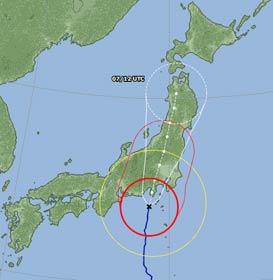I was feeling a little under the weather the other day so I went for a visit to our local medical clinic. Japan’s medical system is quite good, and there are many places to get care when you’re sick, from large hospitals to more specialized medical clinics. As usual, I was struck by what a social place waiting rooms of doctor’s offices are, as a half dozen people aged 60 and up engaged in warm conversation with each other, since they come see the doctor most every day, probably to talk with their friends as much as to treat some ailment. Doctors in Japan all seem to have a complex about English, since they’ve studied an extra four years or so of medical terminology, and they’re often disappointed to learn that the average English speaker doesn’t know the complex terms for this condition or that. Like universities and elementary/ junior high schools in Japan, public hospitals can really surprise you when you go there the first time. Most are old, built in the style I like to call Late Modern Chernobyl, with few niceties or decorations. The buildings are old, but the equipment inside is modern, so I guess they get the job done.
Our house is finally done with the long “reform” (as home remodelling is called in Japan), and we’re enjoying being able to sit in our living room again after almost three months. Our house is quite interesting, a traditional Japanese home built in the 1970s, with a liquor shop in the front and a traditional bo-TON toilet, which is to say, a seatless Japanese toilet which makes a bo-TON (er, splashing) sound when something is deposited into it (trust me, you don’t want to know more). The second floor was added 15 years ago when I came to live there, and they put in regular plumming just for their new American son, and we’ve remodeled twice as our family grew. We’re what’s called a nisetai jutaku (二世帯住宅) or dual-household residence, since both my wife’s parents and our family live there, quite a common thing in a country where the oldest child generally lives with their parents for life. During the most recent construction, I learned a lot about how the still-traditional world of craftsmen in Japan works, watching the daiku, or Japanese carpenters, who have to be as adept at working with 2×4 wood imported from overseas as with installing tatami rooms and shoji paper doors. Incidentally, the word “2×4” is not one Japanese carpenters like, since it smacks of cheap, standardized construction, something unimaginable in Japanese home building before modern times, but sho ga nai (“it can’t be helped”) today.

One of the more unique aspects of Japan is the homogeneous nature of its people, officially known as Yamato Japanese. Of course, Japanese people are not all that similar — if you pay attention you can see a wide variation in features, skin type, hair color, facial shape and so on — but one of the pillars of Japanese society is to not acknowledge any of these individual differences when dealing with other Japanese people. When I worked as an ESL teacher, a lot of my students were fascinated by my gaijin features like my blonde hair and hazel eyes, and by the fact that my eyes changed color depending on what I was wearing. (All Japanese eyes are brown, although for some reason they will insist that they are “black.”) The golden hair on my arms attracted kids, too, who would pull on the hairs during lessons. Japanese are also amazed at how large the feet of Westerners can be. My shoe size here is 26.5 cm (I’ve long forgotten what it is in the American system) so I can usually find shoes here, but my friends with 33 cm and larger feet usually had a hard time when trying to rent ski boots.















